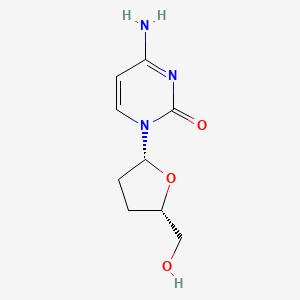D0127 | Zalcitabine
J
J05AF03 Zalcitabine
[J05AF] Nucleoside and nucleotide reverse transcriptase inhibitors
[J05A] DIRECT ACTING ANTIVIRALS
[J05] ANTIVIRALS FOR SYSTEMIC USE
[J] Antiinfectives for systemic use
| Toxicity | Dose | Time | Species | Model | Method | Action | Positive criterion | Reference |
|---|---|---|---|---|---|---|---|---|
| ELECTRON TRANSPORT CHAIN | Interfere | 307 | ||||||
| ULTRASTRUCTURE | abnormalize | 307 | ||||||
| ROS PRODUCTION | Increase | 307 | ||||||
| MITOCHONDRIAL DNA METABOLIC PROCESS | 194 | |||||||
| MITOCHONDRIAL DNA METABOLIC PROCESS | increase | 307 | ||||||
| MITOCHONDRIAL PROTEIN TRANSLATION | decrease | 307 | ||||||
| Target | Dose | Time | Species | Model | Method | Action | Positive criterion | Reference |
|---|---|---|---|---|---|---|---|---|
| Cytochrome c oxidase | Inhibition | 307 | ||||||
| Citrate synthase, mitochondrial | Inhibition | 307 | ||||||
| DNA polymerase gamma | 194 | |||||||
| Reactive oxygen species | increase | 307 | ||||||
| Pictogram | Signal | Statements | Precautionary Statement Codes |
|---|---|---|---|
 |
Warning |
Aggregated GHS information provided by 46 companies from 4 notifications to the ECHA C&L Inventory. Each notification may be associated with multiple companies. H351 (97.83%): Suspected of causing cancer [Warning Carcinogenicity] H361 (15.22%): Suspected of damaging fertility or the unborn child [Warning Reproductive toxicity] Information may vary between notifications depending on impurities, additives, and other factors. The percentage value in parenthesis indicates the notified classification ratio from companies that provide hazard codes. Only hazard codes with percentage values above 10% are shown. |
P201, P202, P281, P308+P313, P405, and P501; (The corresponding statement to each P-code can be found at the GHS Classification page.) |
 |
Danger |
H341: Suspected of causing genetic defects [Warning Germ cell mutagenicity] H351: Suspected of causing cancer [Warning Carcinogenicity] H361: Suspected of damaging fertility or the unborn child [Warning Reproductive toxicity] H362: May cause harm to breast-fed children [Reproductive toxicity, effects on or via lactation] H372: Causes damage to organs through prolonged or repeated exposure [Danger Specific target organ toxicity, repeated exposure] |
P201, P202, P260, P263, P264, P270, P281, P308+P313, P314, P405, and P501; (The corresponding statement to each P-code can be found at the GHS Classification page.) |
| .beta.-D-2',3'-Dideoxycytidine | .beta.-D-2',3'-Dideoxycytidine & Granulocyte-macrophage colony-stimulating factor | .beta.-D-DDC |
| 1-(2,3-Dideoxy-beta-D-ribofuranosyl)cytosine | 2', 3'-dideoxycytidine | 2',3'-DIDEOXYCYTIDINE |
| 2',3'-Dideoxycytidine & Interferon.alpha. | 2',3'-Dideoxycytidine & Nanoparticles (from human serum albumin or polyhexylcyanoacrylate) | 2',3'-Dideoxycytidine & sCD4(soluble recombinant protein) |
| 2',3'-Dideoxycytidine, 98% | 2',3'-Dideoxycytidine, >=98% (HPLC) | 2',3'-Dideoxycytidine, >=99.0% (HPLC) |
| 2,3-dideoxycytidine | 3'-Azido-3'-deoxythymidine/2',3'-Dideoxycytidine | 3-[(5S,2R)-5-(hydroxymethyl)oxolan-2-yl]-6-amino-3-hydropyrimidin-2-one |
| 4-AMINO-1-[(2R,5S)-5-(HYDROXYMETHYL)OXOLAN-2-YL]-1,2-DIHYDROPYRIMIDIN-2-ONE | 4-Amino-1-((2R,5S)-5-(hydroxymethyl)tetrahydrofuran-2-yl)pyrimidin-2(1H)-one | 4-Amino-1-(5-hydroxymethyl-tetrahydro-furan-2-yl)-1H-pyrimidin-2-one |
| 4-Amino-1-[(2R,5S)-5-(hydroxymethyl)oxolan-2-yl]pyrimidin-2(1H)-one | 4-amino-1-[(2R,5S)-5-(hydroxymethyl)tetrahydrofuran-2-yl]pyrimidin-2(1H)-one | 4-amino-1-[(2R,5S)-5-(hydroxymethyl)tetrahydrofuran-2-yl]pyrimidin-2-one |
| 42060-EP2295503A1 | 42060-EP2298761A1 | 42060-EP2305695A2 |
| 42060-EP2305696A2 | 42060-EP2305697A2 | 42060-EP2305698A2 |
| 42060-EP2311808A1 | 42060-EP2311829A1 | 481D892 |
| 5-25-14-00313 (Beilstein Handbook Reference) | 6L3XT8CB3I | 7481-89-2 |
| 78798-EP2298783A1 | 78798-EP2305695A2 | 78798-EP2305696A2 |
| 78798-EP2305697A2 | 78798-EP2305698A2 | AB0014137 |
| AB01085 | AB2000246 | AC-824 |
| AKOS015854844 | AKOS015894505 | ANW-36530 |
| AOB5609 | BCP13878 | BDBM50145605 |
| BPBio1_001378 | BRN 0654956 | BSPBio_001253 |
| C07207 | C9H13N3O3 | CAS-7481-89-2 |
| CCG-101050 | CCRIS 692 | CHEBI:10101 |
| CHEMBL853 | CPD000058253 | CS-1110 |
| Cytidine, 2',3'-dideoxy- | Cytidine, 2',3'-dideoxy- & Colony-stimulating factor | Cytidine, 2',3'-dideoxy- & Interferon.alpha. |
| D 5782 | D00412 | D3581 |
| DB-019728 | DB00943 | DS-4152 & ddC |
| DSSTox_CID_3747 | DSSTox_GSID_23747 | DSSTox_RID_77182 |
| DTXSID0023747 | Dideoxycytidine | EU-0100360 |
| GTPL4828 | HIVID | HMS1548B19 |
| HMS1571O15 | HMS2051H18 | HMS2090C12 |
| HMS2098O15 | HMS2236N08 | HMS3261G21 |
| HMS3715O15 | HSDB 7156 | HY-17392 |
| Hivid (TN) | Hivid(TM) | Hivid;Dideoxycytidine;NSC 606170 |
| Interferon AD + ddC | J-700276 | K278 |
| KS-00000MRJ | KS-1130 | LP00360 |
| LS-1645 | Lecithinized superoxide dismutase & .beta.-D-2',3'-Dideoxycytidine | Lopac0_000360 |
| M-2084 | MCULE-6071296177 | MFCD00012188 |
| MLS000069636 | MLS000759540 | MLS001055363 |
| MLS001424210 | MLS006011951 | NC00300 |
| NCGC00090705-01 | NCGC00090705-02 | NCGC00090705-03 |
| NCGC00090705-05 | NCGC00090705-06 | NCGC00090705-07 |
| NCGC00090705-08 | NCGC00090705-09 | NCGC00090705-10 |
| NCGC00090705-11 | NCGC00090705-13 | NCGC00090705-15 |
| NCGC00179242-01 | NCGC00257202-01 | NCGC00259204-01 |
| NCGC00261045-01 | NSC 606170 | NSC-606170 |
| NSC-759655 | NSC606170 | NSC759655 |
| PC-SOD & ddC | Pharmakon1600-01502360 | Prestwick0_001037 |
| Prestwick1_001037 | Prestwick2_001037 | Prestwick3_001037 |
| Q-201941 | Q2344582 | RTC-064018 |
| Ro 24-2027/000 | Ro-24-2027/000 | Ro-24-2027000 |
| Ro-242027000 | Ro-242027000/Ro-24-2027-000 | SAM001246779 |
| SBB066036 | SC-09165 | SCHEMBL3598 |
| SMR000058253 | SPBio_003104 | SR-01000075822 |
| SR-01000075822-1 | SR-01000736919 | SR-01000736919-5 |
| SRI-7707 | SRI-7707-13 | SRI-7707-14 |
| SRI-7707_15 | SRI-7707_17 | ST069364 |
| ST24043185 | SW197364-4 | Sulfated polysaccharide-peptidoglycan DS-4152 & 2',3'-Dideoxycytidine |
| TC-064018 | TimTec1_004969 | Tox21_113491 |
| Tox21_113491_1 | Tox21_201655 | Tox21_303169 |
| Tox21_500360 | UNII-6L3XT8CB3I | UPCMLD-DP115 |
| UPCMLD-DP115:001 | WREGKURFCTUGRC-POYBYMJQSA-N | Z1550648753 |
| ZINC39906 | Zalcitabine (JAN/USP/INN) | Zalcitabine [USAN:INN:BAN] |
| Zalcitabine [USAN:USP:INN:BAN] | Zalcitabine, 2'3'-Dideoxycytidine | Zalcitabine, United States Pharmacopeia (USP) Reference Standard |
| Zalcitibine | bmse000712 | ddC |
| ddC & GM-CSF | ddC & IFN.alpha. | ddC & Interferon.alpha. |
| ddC & NP (from PHCA or HSA) | ddC & sCD4 | ddC (Antiviral) |
| ddC;Dideoxycytidine;2',3'-Dideoxycytidine | ddCyd | ddC|||2',3'-Dideoxycytidine |
| dideoxycytidine (DDC) | s1719 | zalcitabine |
| DrugBank Name | Zalcitabine |
| DrugBank | DB00943 |
| CAS Number | 107-95-9, 7481-89-2 |
| PubChem Compound | 24066 |
| KEGG Compound ID | C07207 |
| KEGG Drug | D00412 |
| PubChem.Substance | 46507879 |
| ChEBI | 10101 |
| PharmGKB | PA451950 |
| ChemSpider | 22498 |
| BindingDB | 50145605.0 |
| TTD | DNC000527 |
| Wikipedia | Zalcitabine |
| DPD | 884 |

